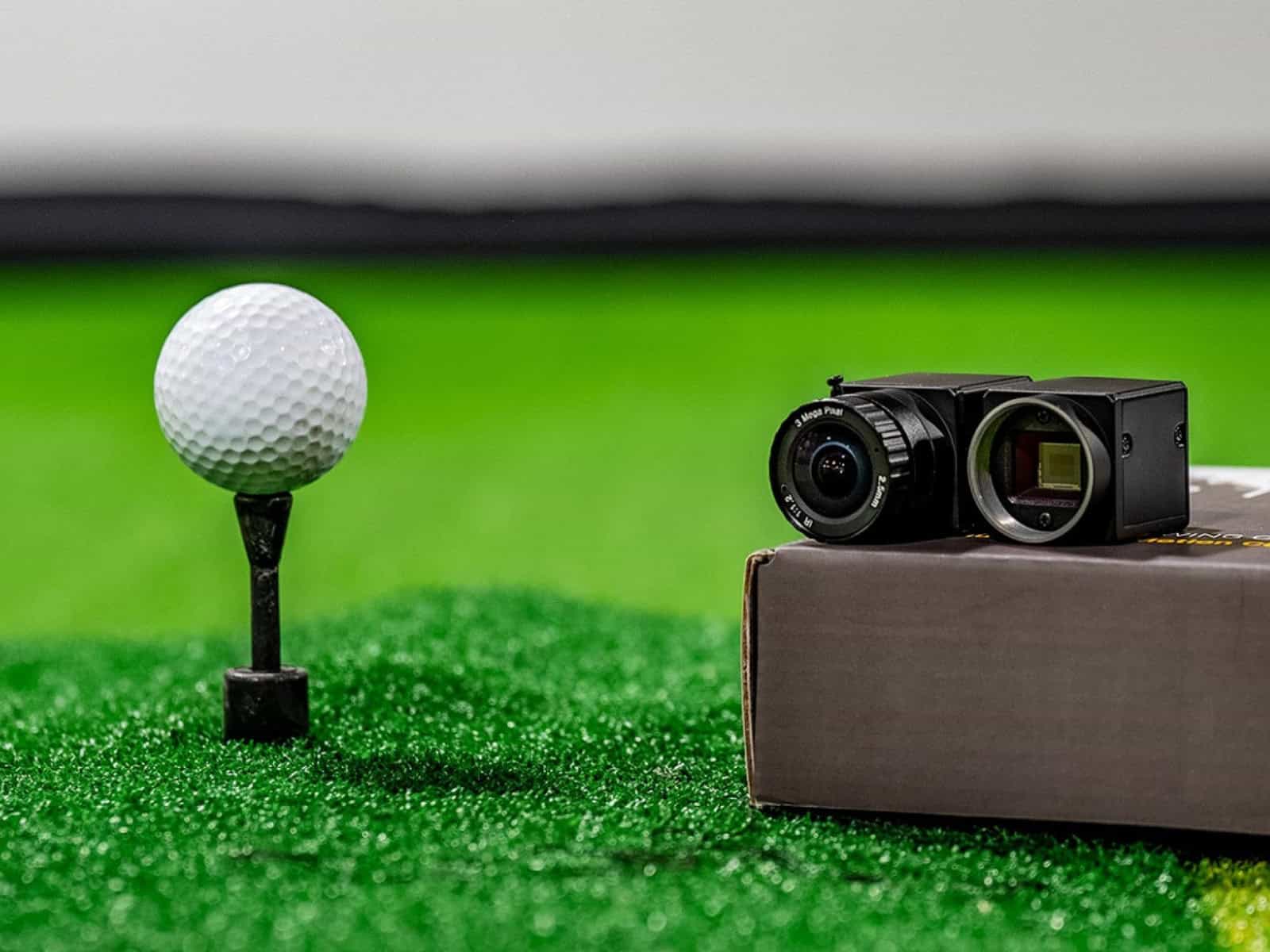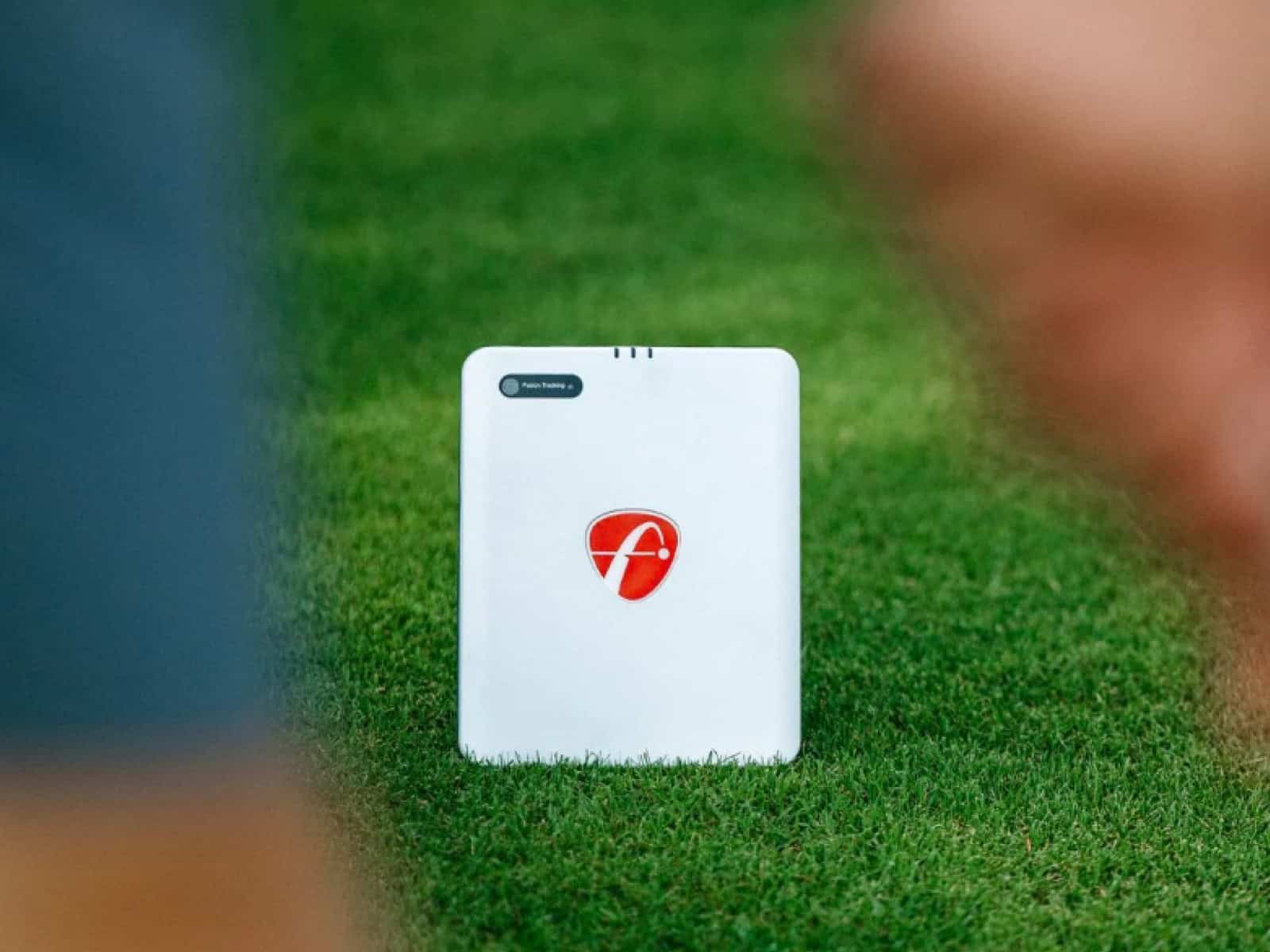Most golfers never see what their swing truly looks like, let alone in 180 frames per second. We tested the Uneekor Swing Optix system to find out if it delivers the kind of slow-motion feedback that actually improves performance. This is a test-based review built on hours of hands-on use.
Swing Optix captures every detail from face-on and down-the-line angles. Paired with Uneekor’s View software, it shows what your swing looks like the moment you strike the ball, with no delay or assumptions.
If you’re working on your mechanics or coaching others, this review will help you decide if Swing Optix belongs in your simulator setup.
What’s Included in the Box?
We tested the Uneekor Swing Optix package from top to bottom, literally starting with the packaging. And from first glance, it’s clear this isn’t a casual swing cam setup. Everything inside signals a serious training tool built for accuracy, clarity and long-term use.
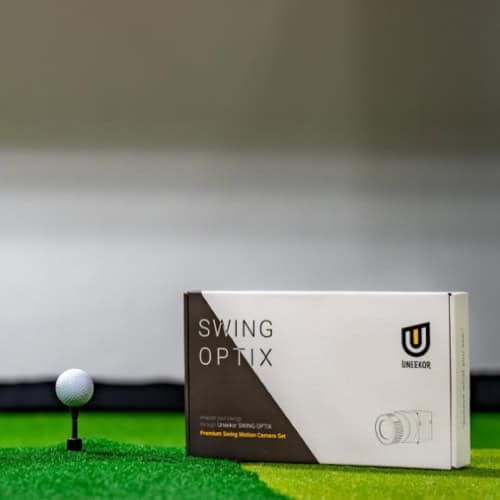
Inside the box, you’ll find:
- Two synchronized high-speed cameras
One for the face-on angle and one for the down-the-line view. These are identical units with different placement roles in your setup. - Mounting arms and hardware
Fully adjustable arms with mounting brackets for wall or ceiling installation. The joints lock tightly and allow precise angle control. - USB and power cables
Long enough for flexible placement, with simple PC connection. A dual power supply system keeps both cameras running without added hardware. - Quick-start guide
Clear, concise setup instructions with diagrams. You won’t need to guess your way through the process. - Software integration sheet
Includes instructions for syncing the cameras with Uneekor View or Refine+ software. Everything is built around plug-and-play logic.
First Impressions
The cameras feel heavy in the right way, with solid metal casing and no loose joints or plastic flex. Each unit is compact, but clearly built for high performance over time. The matte finish helps cut reflections, and every piece feels like it belongs in a high-end simulator bay.
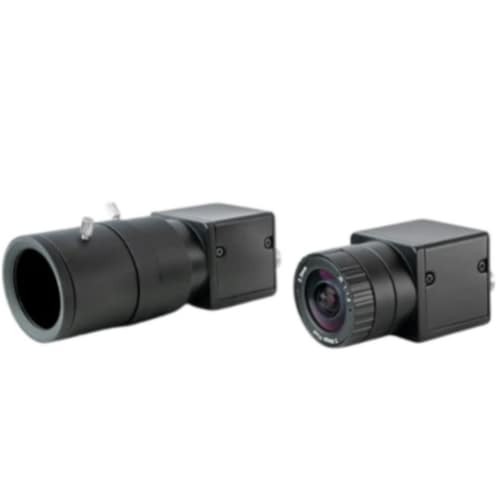
Mounting arms are fully adjustable. They rotate smoothly and lock firmly, which makes fine-tuning angles simple. Once set, the cameras stay put (no sagging or re-aiming mid-session). Cable ports are recessed to prevent snagging and keep the setup clean. That’s especially important in tight garage or studio spaces.
Unboxing Experience
Uneekor packed gear like they knew you’d judge every detail. Each item sits in precision-cut foam. Cables are coiled and labeled. Manuals are flat, not folded. It’s clear from the start: this product isn’t rushed.
You don’t need to guess what goes where. Each accessory is separated and marked, which makes sorting fast and frustration-free. The guide walks you through basic setup without tech jargon or fluff. That alone saves time.
Setup and Installation
Everything looks ready on the surface, but getting dual cameras mounted, powered and synced isn’t always straightforward. We tested the process step by step to find out how easy (or tricky) it really is.
Camera Mounting and Positioning
Placement plays a critical role in video quality. One camera is meant for a face-on view, the other for a down-the-line angle. We installed both using ceiling brackets, but tripods work well for those needing mobility or temporary setups.
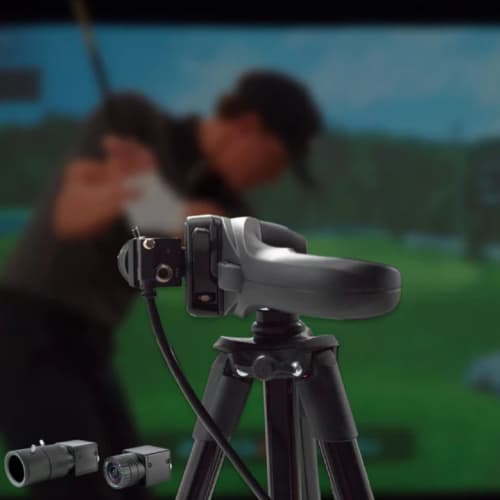
The face-on camera should be centered across from your hitting position at roughly chest height. The down-the-line camera should run parallel to your swing path and be aimed slightly inward to capture full body rotation and club movement.
Mounting arms hold their position once tightened. Getting the right angle and distance took some trial and error, but once set, we didn’t need to readjust.
Connection Process
Each camera connects to a PC via USB and to power using the dual adapter included in the box. Once powered and plugged in, Uneekor’s View or Refine+ software recognized both cameras instantly without needing separate drivers or installations.
During testing, we experienced one minor hiccup: a single camera failed to appear until we changed USB ports. It was a quick fix, but it shows that port selection can occasionally affect detection.
Calibration Tips
Focus is adjusted manually using a physical ring on each camera. Shutter speed and exposure are controlled in software, and balancing these correctly reduces blur and improves clarity.
White balance should be fixed early, especially if your lighting varies. This prevents inconsistent tones between recordings. Once configured, settings are saved and automatically applied to future sessions.
Initial calibration takes a few minutes, but skipping it can lead to poor footage. For clean, frame-accurate slow motion, this step makes all the difference.
User Experience and Daily Use
The controls are built into the Uneekor View and Refine+ software. You can switch between camera angles or slow-motion playback with a single click. Everything stays within the main dashboard, so you’re not jumping between menus.
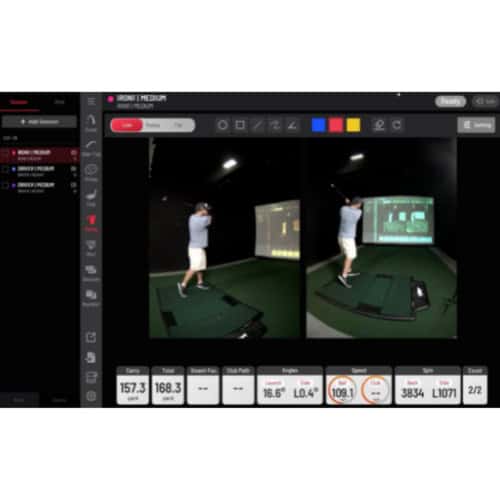
Camera settings like brightness and frame sync are accessible without leaving the interface. If you’re running drills or working with students, having all tools in one place helps keep momentum.
The layout is clean, with no clutter or lag. Even first-time users can locate core features without reading the manual.
Workflow for Practice Sessions
Startup is quick. Power up the PC, open the software and within seconds, the cameras are live. There’s no delay between shot and playback. Each swing automatically records and appears as a clip in your session timeline.
Video and data pair in real time. Launch monitor metrics sync with visual footage instantly, letting you review a miss-hit or groove check on the spot. You can tag swings, name drills or trim videos without pausing the session.
Exporting is simple. Save clips locally or share them through external drives or cloud platforms. Whether you’re practicing solo or reviewing footage with a coach, the entire workflow supports speed and clarity without interruption.
Video Performance and Frame Quality
Each camera records at 180 frames per second, capturing every phase of the swing in stunning detail. From takeaway to follow-through, you can isolate exact moments, whether it’s wrist hinge, impact or hip stall. The footage holds up even at full speed, but slow motion is where it really shines.
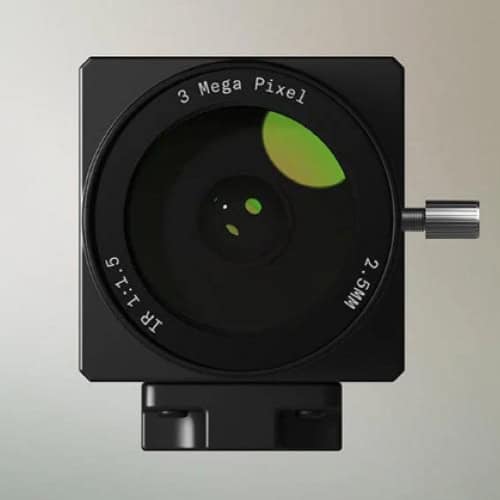
During testing, the video showed no dropped frames or stutters. Each clip played smoothly, allowing clean frame-by-frame analysis. Even fast swings with driver or wedge stayed sharp without blurring, which matters when you’re looking for millisecond-level cues.
The cameras also adapt well to movement. There’s no ghosting or drag. You can pause at any frame and see the club face, shaft lean and body angles with precision.
Lighting Requirements
Under normal indoor lighting, the image remained clear but slightly soft. Adding a pair of LED panels near the hitting zone improved sharpness and reduced shadows. If your garage or studio has poor lighting, clarity will suffer, but not collapse.
For the best results, position bright, diffused lighting on both sides of the player. Avoid direct beams or harsh shadows. We also tested infrared lighting, which worked surprisingly well, especially during evening sessions.
The cameras don’t need perfect conditions, but give them clean light and they’ll reward you with footage that reveals more than you’d expect.
Swing Feedback & Visual Coaching Value
One camera gives you part of the picture. Two show you everything. The face-on view highlights balance, spine angle and wrist movement. The down-the-line view tracks path, plane and clubface through impact. Together, they create a full swing map without guessing.
During practice, we saw how small changes in grip or posture affected swing path and ball flight. The dual view confirmed cause and effect instantly. You don’t need to wait until post-session to diagnose a block or hook. You see it, pause it and fix it before the next swing.
Integration with Data
What makes this system powerful is the pairing with real-time launch data. Swing Optix integrates directly with Uneekor’s metrics. You hit a shot, and within seconds, you can review both the flight numbers and the movement that caused them.
We tested this by intentionally hitting draws, fades and pushes. Every time, the footage confirmed exactly what the numbers suggested. Club path, face angle and swing direction didn’t just appear on a graph—they showed up on screen in motion.
You can tag swings, export key moments and compare drills visually. With the AI Trainer, you can even track progress over time using consistent visuals. The moment your body and data match, improvement clicks. And seeing it happen builds more confidence than any number alone.
For a deeper dive into how this technology translates into coaching, our Uneekor AI Trainer review breaks down whether AI-driven guidance can truly enhance player development and make practice more efficient.
Software Compatibility
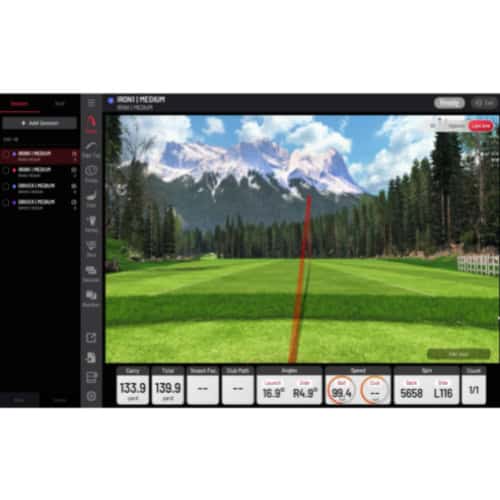
The cameras sync directly with View and Refine+, Uneekor’s proprietary software. No external driver is needed. Launch the program, and the system detects both cameras automatically. Everything works natively, and camera feeds appear in the same window as swing data, launch metrics and video playback tools.
You can tag shots, create player folders, organize by date or drill, and replay swings from multiple angles without lag. During testing, we used these features to compare sessions, diagnose swing faults and review specific drills. The UI stays clean and stable even under extended use.
Playback tools offer speed control, frame stepping and dual-view sync. Whether you’re running a session solo or coaching live, the software makes accessing footage fast and reliable.
Limitations with Third-Party Software
Here’s where the flexibility stops. Swing Optix does not natively support Swing Catalyst, V1 Pro, or other popular swing analysis programs. The cameras do not function as generic webcams or plug into third-party apps via USB video class drivers.
We tested screen capture as a workaround, recording footage from View or Refine+ and importing it manually. It works, but it adds steps. File transfers, trimming and tagging must all be repeated outside the native interface. For some instructors, that’s a deal breaker.
If you rely heavily on third-party analysis platforms, this limitation could impact your current setup. But if you’re all-in on Uneekor, the native integration feels fast, stable and built for daily use. And with every swing recorded and filed without delay, the time you save adds up fast.
Ideal Users and Use Cases
The Uneekor Swing Optix system isn’t built for casual experimentation. It’s built for golfers, coaches and fitters who want clarity on every swing, session and adjustment. But who benefits most from its capabilities? The answer depends on how you train, teach or fit.

Home Simulator Owners
For serious at-home golfers, Swing Optix offers the missing piece in solo practice. The dual-camera setup gives a front and side view of each swing, letting you study movement without guesswork. You can see head drift, hip sway and club path in detail.
Daily swings can be recorded and reviewed, helping track swing changes over time. You can tag swings, mark changes after drills and isolate sessions to compare form. Instead of relying on feel or ball flight alone, you now have video proof of progress—or problems.
Golf Coaches and Trainers
Teaching feels different when the camera does the talking. Coaches can show a student two synchronized views of a swing: one face-on, one down-the-line, and break down angles in slow motion. It builds trust, as students believe what they see.
With View or Refine+, instructors can tag swings by student, drill or focus. Replay is instant and feedback is clear. Lessons get tighter because explanations need fewer words.
The most surprising benefit? It speeds up learning. One glance at a paused clip can do more than five minutes of verbal instruction. And every saved swing becomes a reference for the next lesson.
Club Fitters and Retail Studios
Fitting isn’t just about numbers; it’s about movement. Swing Optix lets fitters show clients how different shafts or clubheads affect their motion. A video side-by-side of “before” and “after” can validate a fit instantly.
You can also demonstrate how changes to lie angle or length impact posture, rotation or balance. Combine the footage with launch monitor data, and clients leave with full confidence in their fit.
Limitations and Considerations
Every advanced system has trade-offs, and Swing Optix is no exception. Understanding its constraints helps you make smarter decisions before you hit record.
Limited Software Compatibility
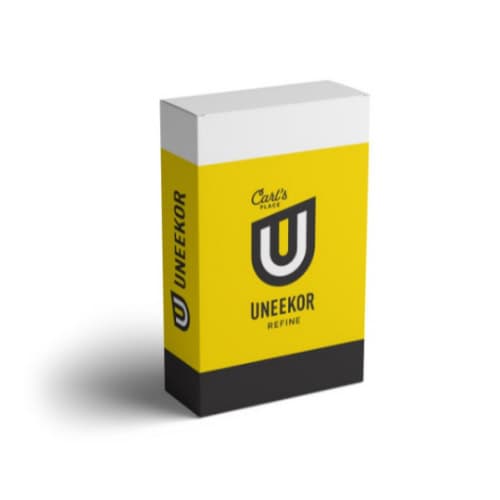
Swing Optix works exclusively with Uneekor’s View and Refine+ software. There’s no native support for popular third-party platforms like Swing Catalyst or V1 Pro. This limits flexibility for instructors who rely on cross-platform tools or existing workflows.
While some users attempt workarounds using screen capture software, these come with lag, resolution loss and potential sync issues. If you already use another swing analysis platform, this limitation matters.
Lighting Is Critical
The cameras deliver sharp footage when the lighting is right. Uneven or dim setups can introduce noise or blur, especially during fast motion. Users training in garages or basements often need LED panels or IR lighting to maintain clarity.
Proper placement of lights matters just as much. A poorly lit subject can undo the benefit of 180 FPS video. Investing in the right lighting is part of the equation.
No Modular Buying Options
Swing Optix comes as a matched pair. There’s no option to buy just one camera. This makes sense for synchronized capture, but it limits flexibility and increases entry cost for those who might only want one angle.
You also can’t upgrade piece-by-piece. The package is all or nothing.
This is a professional tool, and the price (around $1,700) reflects that. Swing Optix costs more than standard swing cameras, and there are no stripped-down versions. If you’re seeking a budget solution or a casual tool, this may feel out of reach.
But the price isn’t just for the hardware. It’s for integration, frame quality and multi-angle capture. For those who need those features, it may still be a smart investment.
Where to Buy?
You’ve done the research. You know the features. You’re ready to buy. But where you buy the Uneekor Swing Optix system can shape your overall experience and what extras you might walk away with.
The Swing Optix camera set is available from several top-tier golf sim suppliers. Each offers different perks, shipping speeds and bundling opportunities.
Bundling Opportunities
If you’re planning to build a full simulator setup, bundled deals save money and simplify installation. Look for combo packages with:
- Eye XO or Eye Mini launch monitors
- SwingBay or Carl’s Place enclosures
- Hitting mats and projector mounts
- Software upgrades (Refine+ or GSPro compatibility)
Holiday sales and seasonal promos are prime opportunities to secure the Swing Optix system at a better price or to score free upgrades.
Things to Watch For
- Verify software version: Ensure the package includes View or Refine+ license details.
- Shipping timelines: Some suppliers show faster availability than others—always check lead times.
- Return policy: Since this is a premium system, be aware of restocking fees or final sale conditions.
Frequently Asked Questions
Golfers often have key questions before investing in Swing Optix. Here are the answers to the most common ones, based on hands-on usage and direct software integration experience.
Can I use Swing Optix without a Uneekor launch monitor?
Does it work in a dark room or garage setup?
Yes, but lighting plays a huge role in image clarity. While the cameras perform well in moderate lighting, setups in garages or dark indoor spaces benefit from extra LED lights or IR-compatible lighting. Proper lighting brings out full detail in slow-motion playback.
Yes. You can save recordings directly to your PC, then transfer them manually. Sharing via cloud storage email, or external drives is easy. However, there’s no one-click sharing feature inside the View or Refine+ software.
Is there audio recording?
No. Swing Optix cameras do not include microphones or capture audio. The focus remains entirely on frame-by-frame video clarity and swing mechanics. If you need audio, you’ll have to set up a separate microphone.
Do I need a high-performance PC?
Yes. To run 180 FPS video capture and playback smoothly, Uneekor recommends a dedicated graphics card, high-speed SSD and a modern processor. Lag or dropped frames are likely on underpowered systems, especially during live recording and data syncing.
Can I analyze putts and chips?
Yes. Swing Optix captures short game motions well, especially when paired with high frame rates and proper lighting. Face-on views help identify wrist break, posture changes and tempo shifts that affect putting accuracy and consistency.
Final Thoughts
Uneekor’s Swing Optix doesn’t just record your swing—it transforms how you see it. The 180 FPS capture freezes every detail, letting you pinpoint breakdowns and breakthroughs in real time. Paired with Uneekor’s software, it creates a loop of feedback and refinement.
What makes Swing Optix stand out is how effortlessly it fits into your practice. From dual-angle footage to clean tagging and export tools, everything works the way you expect.
You’ll need solid lighting and a good PC, but it’s one of the most valuable tools a serious golfer or coach can add to their studio. For those who care about form, tempo and progress (not just numbers), Swing Optix turns footage into feedback you can act on. And that’s the edge most players never see coming.
If you’re looking for a more compact and affordable launch monitor to pair with visual tools like Swing Optix, our Uneekor Eye Mini Lite review highlights how this smaller unit performs indoors while still delivering accurate data for serious practice.


